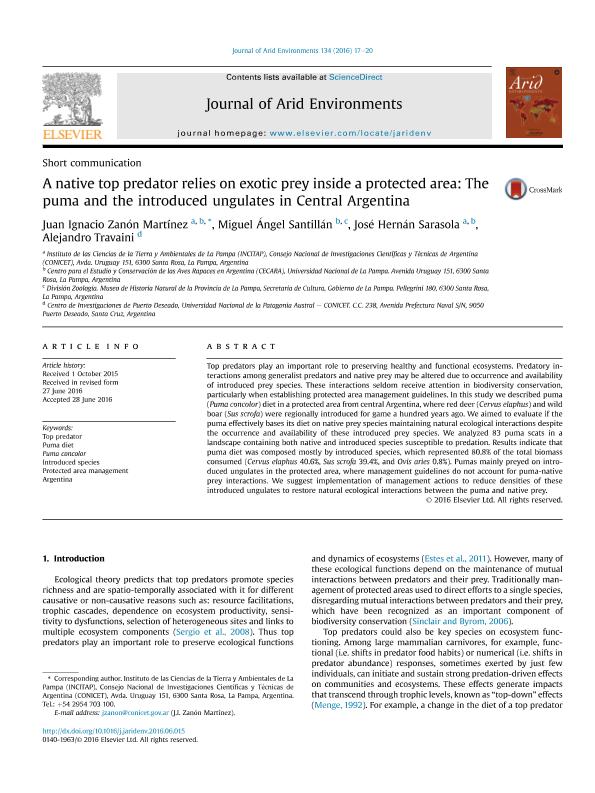Artículo
A native top predator relies on exotic prey inside a protected area: The puma and the introduced ungulates in Central Argentina
Fecha de publicación:
11/2016
Editorial:
Academic Press Ltd - Elsevier Science Ltd
Revista:
Journal of Arid Environments
ISSN:
0140-1963
Idioma:
Inglés
Tipo de recurso:
Artículo publicado
Clasificación temática:
Resumen
Top predators play an important role to preserving healthy and functional ecosystems. Predatory interactions among generalist predators and native prey may be altered due to occurrence and availability of introduced prey species. These interactions seldom receive attention in biodiversity conservation, particularly when establishing protected area management guidelines. In this study we described puma (Puma concolor) diet in a protected area from central Argentina, where red deer (Cervus elaphus) and wild boar (Sus scrofa) were regionally introduced for game a hundred years ago. We aimed to evaluate if the puma effectively bases its diet on native prey species maintaining natural ecological interactions despite the occurrence and availability of these introduced prey species. We analyzed 83 puma scats in a landscape containing both native and introduced species susceptible to predation. Results indicate that puma diet was composed mostly by introduced species, which represented 80.8% of the total biomass consumed (Cervus elaphus 40.6%, Sus scrofa 39.4%, and Ovis aries 0.8%). Pumas mainly preyed on introduced ungulates in the protected area, where management guidelines do not account for puma-native prey interactions. We suggest implementation of management actions to reduce densities of these introduced ungulates to restore natural ecological interactions between the puma and native prey.
Palabras clave:
Top Predator
,
Puma Diet
,
Puma Concolor
,
Introduced Species
Archivos asociados
Licencia
Identificadores
Colecciones
Articulos(INCITAP)
Articulos de INST.D/CS D/L/TIERRA Y AMBIENTALES D/L/PAMPA
Articulos de INST.D/CS D/L/TIERRA Y AMBIENTALES D/L/PAMPA
Citación
Zanón Martínez, Juan Ignacio; Santillán, Miguel Ángel; Sarasola, José Hernán; Travaini, Alejandro; A native top predator relies on exotic prey inside a protected area: The puma and the introduced ungulates in Central Argentina; Academic Press Ltd - Elsevier Science Ltd; Journal of Arid Environments; 134; 11-2016; 17-20
Compartir
Altmétricas




